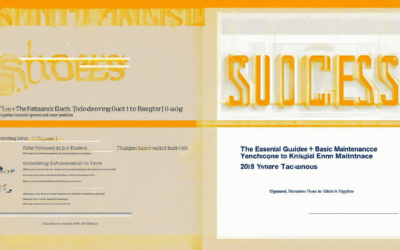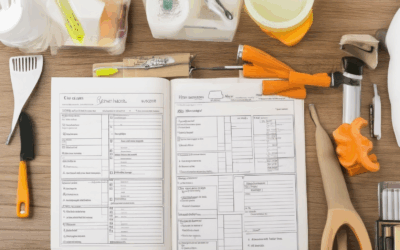Keeping your home in top shape is essential for preserving its value and preventing costly repairs down the line. Whether you’re a seasoned homeowner or new to the responsibilities, maintaining your property requires a combination of routine care and strategic planning. This comprehensive guide offers a detailed checklist tailored to address both immediate and long-term needs, ensuring your home remains in peak condition year-round. From budgeting basics to seasonal-specific tasks, this article covers everything you need to know to stay ahead of potential issues and extend the life of your home. Discover practical tips, downloadable resources, and expert advice to help you prioritize your home maintenance effectively.

What Routine Maintenance Is Required for a House?
Keeping your house in great shape requires regular maintenance to prevent issues before they arise. Here’s a comprehensive guide to the essential tasks:
- Check for Leaks
- Inspect pipes under sinks, bathtubs, and toilets for visible leaks.
- Look for water damage around fixtures or flooring.
- Test exposed pipes for rust or corrosion.
- Clean Gutters and Downspouts
- Remove debris like leaves, branches, and dirt from gutters and downspouts.
- Ensure water flows freely to prevent water buildup and foundation issues.
- Examine Windows and Doors
- Check for cracks, gaps, or peeling paint in window frames and doors.
- Insulate windows to improve energy efficiency.
- Lubricate door hinges and ensure screens are intact.
- Service HVAC Systems
- Schedule a professional inspection of your furnace, air conditioning, and ductwork.
- Replace or clean air filters monthly to maintain airflow and efficiency.
- Check for signs of wear or damage in vents and ducts.
- Inspect the Roof
- Look for missing shingles, curling edges, or damage from weather.
- Clear debris like leaves and branches from the roof and flashing.
- Check for any sagging or uneven surfaces.
- Test Smoke Detectors and Carbon Monoxide Sensors
- Ensure smoke detectors and CO sensors are functioning properly.
- Replace batteries as needed, typically twice a year.
- Clean and Service Appliances
- Daily cleaning of major appliances like refrigerators, stoves, and dishwashers.
- Monthly servicing of washing machines, dryers, and garbage disposals.
- Check for worn-out parts or necessary repairs.
- Check Foundation for Cracks or Damage
- Inspect the perimeter of your house for any cracks or shifting.
- Look for signs of moisture or rot around the foundation.
- Consider sealing cracks or gaps to prevent water intrusion.
- Service Landscaping
- Trim trees and bushes to maintain proper spacing and avoid encroachment.
- Mow and edge lawn areas regularly.
- Inspect for invasive plants or pests that could harm your property.
- Check for Pest Infestations
- Look for signs of pests like rodents, ants, or spiders.
- Seal entry points to prevent infestations.
- Contact a professional exterminator if needed.
- Inspect Driveways and Walkways
- Check for cracks, potholes, or uneven surfaces.
- Remove debris like rocks or grass clippings.
- Apply sealant to protect against weather damage.
- Service Garage Door and Opener
- Lubricate the garage door tracks and opener mechanism.
- Inspect for loose screws or worn-out parts.
- Test the automatic opener functionality.
- Check Fire Safety Devices
- Ensure fire extinguishers are fully charged and functional.
- Inspect smoke detectors and carbon monoxide sensors annually.
- Review Insurance Policies
- Verify that your home insurance covers damages from storms, fires, or other disasters.
- Update policy details as needed to reflect changes in your home’s condition.
- Inspect Attic and Basement
- Check for water leaks or mold growth in attics and basements.
- Ensure storage areas are clean and organized.
- Look for structural issues like sagging beams or joists.
- Service Water Heater
- Flush the water heater to remove sediment buildup.
- Check for leaks or unusual noises.
- Replace the tank if it’s nearing its lifespan.
- Check for Dead Trees or Overgrown Plants
- Remove dead trees or branches that could pose a risk during storms.
- Trim overgrown plants near windows and walkways.
- Service Pool and Spa
- Check pool water chemistry and filter functionality.
- Inspect spa jets and tiles for damage or wear.
- Ensure proper draining and winterizing if applicable.
- Inspect Outdoor Lighting
- Check for loose bulbs or broken sockets.
- Ensure lights are secure and free from wobbling.
- Test timers or motion sensors for proper operation.
- Service Outdoor Furniture
- Inspect for rust or damage from weather exposure.
- Move furniture indoors during inclement weather.
- Apply waterproofing treatments as needed.
- Check for Termite Damage
- Look for signs of termite activity or damage.
- Consult a professional if you suspect an infestation.
- Service Grills and Outdoor Cooking Equipment
- Clean and lubricate grills before use.
- Inspect gas lines for leaks or damage.
- Ensure outdoor cooking equipment is stable and secure.
- Inspect Fire Pits and Outdoor Heating Elements
- Check for damage or rust on fire pits and heaters.
- Ensure venting systems are clear and functional.
- Test ignition features and safety mechanisms.
- Service Driveway and Sidewalks
- Fill cracks and potholes to prevent tripping hazards.
- Remove debris and level surfaces.
- Apply sealant to extend surface life.
- Inspect for Hail Damage
- Look for dents or granulated impact marks on roofing materials.
- Have damaged areas inspected by a professional.
- Service Solar Panels (if applicable)
- Clean solar panels to maximize energy production.
- Inspect for loose connections or damage.
- Schedule professional cleaning and maintenance.
- Check for Dead Animal Activity
- Inspect walls, attics, and crawl spaces for animal droppings or nests.
- Seal entry points to prevent future infestations.
- Service Mailbox and Posts
- Inspect mailbox for damage or rust.
- Check posts for stability and security.
- Ensure proper installation and alignment.
- Inspect Fence and Gate
- Check for gaps, holes, or broken sections.
- Ensure gates are secure and open/close smoothly.
- Apply weatherproofing treatments as needed.
- Service Deck and Porch
- Inspect deck boards for warping, rot, or nails popping.
- Check railings for stability and safety.
- Remove debris and apply sealant or stain as needed.
- Inspect Gutter Downspouts
- Ensure downspouts are clear and directed away from the house.
- Check for clogs or blockages.
- Clean or replace as necessary.
- Service Outdoor Water Features
- Check for leaks or malfunctioning pumps.
- Inspect water lines for damage or wear.
- Ensure proper drainage and circulation.
- Inspect for Radon Levels
- Purchase a radon test kit and monitor levels indoors.
- Take action if levels exceed recommended thresholds.
- Service Septic Tanks
- Inspect for proper functioning and leaks.
- Empty holding tanks as needed.
- Schedule professional pumping and maintenance.
- Check for Gas Leaks
- Use a detector to scan for gas leaks around the house.
- Call a professional if detected or suspected.
- Inspect for Lead Paint
- Check painted surfaces, especially those in older homes.
- Test for lead contamination if necessary.
- Remediate if lead paint is found.
- Service Attic and Basement Insulation
- Check for adequate insulation to prevent heat loss or gain.
- Look for drafts or areas where insulation is missing.
- Add or repair insulation as needed.
- Inspect for Mold Growth
- Look for visible mold spores or growth in damp areas.
- Address mold issues promptly to prevent health risks.
- Service Fireplace and Chimney
- Inspect chimney for creosote buildup or damage.
- Check fireplace flues for obstructions.
- Ensure proper ventilation and safety mechanisms.
- Check for Storm Damage
- Inspect exterior surfaces for hail damage or wind damage.
- Look for missing shingles or torn-off siding.
- Contact a professional for repairs if needed.
- Service Plumbing System
- Check for slow drains or recurring clogs.
- Inspect pipes for corrosion or leaks.
- Schedule professional cleaning and maintenance.
- Inspect for Electrical Issues
- Look for flickering lights, buzzing outlets, or overloaded circuits.
- Check for exposed wires or loose connections.
- Contact an electrician for any identified issues.
- Service HVAC Ductwork
- Inspect ducts for dust, dirt, or rodent activity.
- Check for leaks or gaps in the duct system.
- Vacuum ducts and registers to improve airflow.
- Inspect for Rodent Activity
- Look for gnaw marks, droppings, or nesting materials.
- Seal entry points to prevent infestations.
- Contact a professional exterminator if needed.
- Service Ceiling Fans and Exhaust Fans
- Inspect fans for loose blades or wobbly motors.
- Ensure exhaust fans are functioning properly.
- Clean fan blades and vent ducts regularly.
- Inspect for Pest Control Issues
- Check for wasps, bees, or other stinging insects.
- Eliminate food sources to deter pests.
- Contact a professional exterminator if needed.
- Service Pool and Spa Chemicals
- Test water chemistry and adjust levels as needed.
- Replace outdated or expired chemicals.
- Sanitize and chlorinate water regularly.
- Inspect for Water Softeners
- Check brine tanks for salt buildup or damage.
- Ensure softening systems are functioning properly.
- Schedule professional maintenance as needed.
- Service Water Filters
- Change or clean water filters according to manufacturer guidelines.
- Inspect for leaks or damage in filter housing.
- Ensure proper filtration and water flow.
- Inspect for Gas Lines
- Look for signs of gas leaks around the house.
- Check for damaged or corroded gas lines.
- Contact a professional for inspections and repairs.
- Service Clothes Dryer Vent
- Inspect vent pipe for clogs or damage.
- Ensure proper venting and airflow.
- Clean vent hood and ductwork regularly.
- Inspect for Fire Safety Compliance
- Ensure smoke detectors and alarms meet local codes.
- Check for proper placement and functionality.
- Update or install new systems as needed
Regular Home Maintenance Checklist: 10 Essential Tasks
Keeping your home in great shape requires consistent effort. Here’s a comprehensive guide to essential monthly tasks that will help preserve your property and ensure longevity:
- Plumbing Checkup
- Inspect pipes for leaks or corrosion.
- Run water through each drain to detect clogs.
- Test for slow draining or unusual noises.
- Clean out lint traps in laundry units.
- Electrical System Inspection
- Check all switches and outlets for functionality.
- Ensure GFCIs (Ground Fault Circuit Interrupters) are working.
- Look for tripped breakers and reset them if necessary.
- Heating and Cooling Systems
- Clean or replace air filters monthly.
- Inspect vents for dirt or blockages.
- Schedule professional tune-up annually.
- Exterior Maintenance
- Inspect roof for missing shingles or damage.
- Clean gutters and downspouts to prevent backups.
- Check chimney for cracks or blockages.
- Examine exterior surfaces for peeling paint or rot.
- Appliance Care
- Clean vent hood filters and rangehoods.
- Inspect stove burners for uneven heat or gas leaks.
- Leave dishwasher door open after use to prevent mold.
- Flush water heater to remove sediment.
- Fire Safety Checks
- Test smoke detectors and replace batteries.
- Check fire extinguishers for charge and expiration dates.
- Map out escape routes and conduct drills.
- Flooring and Walls
- Mop and vacuum floors regularly.
- Spot clean walls for stains and peeling paint.
- Address water damage promptly to prevent mold.
- Upholstery and Furniture
- Vacuum frequently to reduce allergens.
- Spot clean spills and stains immediately.
- Use steam cleaning for tough stains.
- Gardening Tasks
- Trim trees and bushes for health and safety.
- Weed the garden to enhance drainage.
- Prune shrubs to encourage new growth.
- Monitor plants for pests and diseases.
- Windows and Doors
- Check for proper sealing to optimize energy efficiency.
- Clean window screens and glass surfaces.
- Test locks and hinges for functionality.
- Professional Services
- Schedule HVAC tune-ups and chimney inspections.
- Call professionals for major repairs or installations.

The 1% Rule for Home Maintenance
The 1% rule for home maintenance suggests setting aside 1% of your home’s appraised value annually to cover routine upkeep and repairs. Here’s a breakdown of how it works and its significance:
- Calculation Method: Determine your home’s appraised value and compute 1% of that figure. For instance, if your home is valued at $200,000, you would allocate $2,000 annually for maintenance.
- Purpose:** The aim is to fund necessary tasks like fixing leaks, repainting walls, inspecting the roof, and addressing other routine issues that arise throughout the year.
- Flexibility:** While the rule suggests a fixed percentage, it’s intended as a guideline. Adjustments can be made based on personal circumstances, such as unexpected repair needs or cost-saving opportunities.
- Scope:** This rule primarily covers maintenance expenses, not improvements or renovations. It focuses on preserving the home’s condition rather than expanding it.
- Comparison with Alternatives:** Unlike other methods, the 1% rule is memorable and straightforward, making it a practical approach for many homeowners. However, individual needs may vary, and other strategies might align better with specific situations.
- Allocation and Prioritization:** Distribute funds across essential areas such as plumbing, HVAC, and exterior work. Prioritize critical tasks first to ensure immediate needs are met without neglecting long-term requirements.
- Review Frequency:** Periodically reassess your maintenance budget, perhaps annually or after significant life events, to account for changing needs and updated priorities.
- Benefits:** Adhering to the 1% rule can prevent minor issues from escalating into major problems, ultimately saving money and preserving your home’s value. It also supports better preparedness for future resale.
- Considerations:** Be mindful of potential pitfalls, such as underestimating maintenance needs or over-saving, which could lead to inefficient use of funds. Effective tracking tools, like spreadsheets or apps, can help manage and optimize your budget.
This rule offers a structured approach to home maintenance, balancing preparation with flexibility to adapt to unique circumstances.

General House Maintenance
General house maintenance refers to the routine tasks and activities required to keep a residential property in good condition. These tasks are essential for preserving the value of the home, ensuring safety, and preventing costly repairs. Below is a comprehensive guide to various aspects of house maintenance.
Key Components of House Maintenance
- Safety Checks: Regularly inspect for potential hazards such as loose floorboards, exposed wires, or damaged railings. Ensure smoke detectors and carbon monoxide alarms are functioning properly.
- Cleaning: Maintain cleanliness in all areas of the house, including bathrooms, kitchens, and living spaces. Dusting, vacuuming, and mopping floors regularly helps prevent dirt buildup and allergens.
- Rodent Control: Inspect for signs of pests like mice or rats and seal entry points to prevent infestations. Use traps or professional services as needed.
- Garbage Disposal: Clean and maintain the garbage disposal unit regularly to prevent clogs and odors. Run it periodically with hot water to clear waste.
- Gardening and Landscaping: Trim trees and bushes, mow the lawn, and maintain flower beds to keep the exterior of the house looking neat and healthy.
- Asset Repairs: Address minor repairs immediately, such as fixing leaky pipes, replacing worn-out caulking, or repairing loose shingles on the roof.
Seasonal Maintenance Tips
Seasonal maintenance plays a crucial role in preserving your home’s integrity. Here are some tips tailored to different times of the year:
Spring Maintenance
- Check for damage caused by winter weather, such as cracked sidewalks or roof damage.
- Clean gutters and downspouts to ensure proper drainage during rainy seasons.
- Inspect windows and doors for cracks or drafts and seal them if necessary.
Summer Maintenance
- Test air conditioning units to ensure they are working efficiently before the hot weather arrives.
- Examine the foundation for cracks or shifts and repair as needed.
- Protect outdoor furniture and plants from extreme heat and pests.
Winter Maintenance
- Prepare pipes for freezing temperatures by insulating them or allowing water to flow gently to prevent bursting.
- Check for drafts around windows and doors and consider upgrading to more efficient models.
- Clear snow and ice from walkways and roofs to prevent slips and structural stress.
Monthly Maintenance Tasks
Establishing a monthly maintenance routine can help keep your home in great shape. Here are some tasks to include:
- Inside the Home: Vacuum and mop floors, clean bathrooms, and check for leaks under sinks or in bathtubs.
- Kitchen: Wipe down countertops, clean appliances, and check expiration dates on food items.
- Exterior: Power wash decks, siding, and driveways. Trim trees and bushes to maintain curb appeal.
- Utilities: Test smoke detectors and change filters as needed. Schedule regular HVAC service to ensure optimal performance.
Long-Term Maintenance Planning
Planning ahead for major maintenance tasks can save you time and money in the long run. Consider the following:
- Roof Inspection: Have your roof inspected annually to check for wear and tear or damage from weather events.
- Plumbing Systems: Replace old pipes and fixtures as needed to prevent leaks and improve water efficiency.
- Heating and Cooling Systems: Schedule regular tune-ups to extend the life of your HVAC equipment and reduce energy costs.
- Electrical Systems: Update outdated wiring and install new outlets or switches as required by local codes.
Energy Efficiency and Security
As part of your maintenance routine, consider upgrades that enhance energy efficiency and home security:
- Insulation: Add attic or wall insulation to lower energy bills and improve indoor comfort.
- Smart Home Devices: Install security cameras, door locks, and smart lighting to boost home security and convenience.
Conclusion
Maintaining your house requires consistent effort and attention. By addressing small issues before they become major problems, you can protect your investment and enjoy a safe, comfortable living environment. Prioritize regular inspections, quick fixes, and preventive measures to keep your home in peak condition.
Budgeting for Home Maintenance
When planning your home maintenance budget, aim to set aside between 1% to 2% of your home’s purchase price annually. This covers routine tasks like roofing repairs, plumbing issues, and appliance replacements, which can each cost thousands of dollars.
If 2% feels overwhelming, start with a smaller percentage, such as 0.5%, and gradually increase it over time. This approach allows you to build up your savings while managing unexpected expenses.
Key Areas to Consider
- Roofing: Expect to spend $300 to $1,500 annually for inspections and potential repairs.
- Plumbing: Annual checks can cost around $100 to $300, depending on the system’s condition.
- Heating, Ventilation, and Air Conditioning (HVAC): Regular maintenance typically costs $100 to $300 yearly.
- Appliances: Replace older models every 5-10 years, with costs varying based on the appliance type.
- Lawn Care and Landscaping: Budget $200 to $600 annually for mowing, planting, and tree care.
- Gutter Cleaning: Plan $150 to $400 yearly to keep water flowing freely and prevent damage.
Additional Tips
- Track Expenses: Use apps or spreadsheets to monitor spending and identify areas where you can cut costs.
- Consider Location: Homes in areas with extreme weather may require more frequent maintenance.
- Diy vs. Professionals: Tackle small jobs yourself to save money, but hire professionals for complex issues.
- Long-Term Benefits: Consistent maintenance prevents costly issues down the line, saving you money in the long run.
- Annual Review: Adjust your budget each year to account for changes in your home’s condition or lifestyle needs.

What is Routine Maintenance Required?
Routine maintenance refers to the consistent and scheduled tasks needed to ensure the smooth operation and longevity of various systems and structures within a property. It involves checking, inspecting, and addressing potential issues before they escalate, thereby preventing costly repairs and extending the lifespan of assets.
Key Components of Routine Maintenance
- Checking and Replacing Light Bulbs: Regularly inspect all lighting fixtures to ensure they are functioning properly. Replace worn-out bulbs to maintain safety and visibility.
- Plumbing Systems: Examine pipes for leaks, cracks, or blockages. Test water pressure and ensure all fixtures are working correctly. Address any issues promptly to prevent water damage.
- Electrical Systems: Inspect circuit breakers, switches, and outlets. Test GFCI outlets to ensure they trip correctly and check for exposed wires or damaged insulation.
- Heating, Ventilation, and Air Conditioning (HVAC): Clean or replace air filters monthly to maintain efficiency. Schedule regular tune-ups to ensure optimal performance and energy efficiency.
- Machinery and Equipment: Perform routine inspections on tools, appliances, and industrial equipment. Lubricate moving parts and check for wear or tear.
- Landscaping and Exterior Maintenance: Trim trees and bushes, mow lawns, and clean gutters. Inspect fences for damage and repair as needed. Check walkways for cracks or uneven surfaces.
- Documentation: Keep a record of all maintenance activities, including dates, tasks performed, and any issues identified. This helps track progress and ensures nothing is overlooked.
Routine maintenance is essential for homeowners and businesses alike. By staying proactive, you can save money, extend the life of your property, and ensure a safer, more comfortable environment. For detailed guides and resources on home maintenance, visit our Home Maintenance Guide .
Need assistance with specific maintenance tasks? Our maintenance services are designed to help you tackle even the most challenging projects with ease.




0 Comments